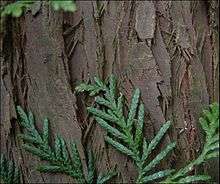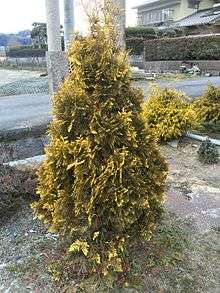Thuja
| arborvitaes | |
|---|---|
 | |
| Thuja standishii foliage and cones | |
| Scientific classification | |
| Kingdom: | Plantae |
| Division: | Pinophyta |
| Class: | Pinopsida |
| Order: | Pinales |
| Family: | Cupressaceae |
| Subfamily: | Cupressoideae[1] |
| Genus: | Thuja L. |
Thuja (/ˈθjuːdʒə/ THEW-jə)[2] is a genus of coniferous trees in the Cupressaceae (cypress family). There are five species in the genus, two native to North America and three native to eastern Asia.[3][4][5][6] The genus is monophyletic and sister to Thujopsis.
They are commonly known as arborvitaes,[7] (from Latin for tree of life) thujas or cedars.
- Thuja koraiensis Nakai - Korean thuja - Jilin, Korea
- Thuja occidentalis L. - Eastern arborvitae, northern whitecedar - E Canada (Manitoba to Nova Scotia), E United States (primarily Northeast, Great Lakes, Appalachians)
- Thuja plicata Donn ex D.Don - Western redcedar - from Alaska to Mendocino County in California
- Thuja standishii (Gordon) Carrière - Japanese thuja - Honshu, Shikoku
- Thuja sutchuenensis (Gordon) Carrière - Sichuan thuja - Sichuan, Chongqing China almost extinct in the wild
- Formerly placed here[3]
- Austrocedrus chilensis (D.Don) Pic.Serm. & Bizzarri (as T. chilensis D.Don)
- Callitris rhomboidea R.Br. ex Rich. (as T. australis Poir.)
- Cupressus nootkatensis D.Don (as T. excelsa Bong.)
- Glyptostrobus pensilis (Staunton ex D.Don) K.Koch (as T. pensilis Staunton ex D.Don)
- Libocedrus plumosa (D.Don) Sarg. (as T. doniana Hook.)
- Platycladus orientalis (L.) Franco (as T. orientalis L.)
- Podocarpus javanicus (Burm.f.) Merr. (as T. javanica Burm.f.)
- Tamarix aphylla (L.) H.Karst. (as T. aphylla L.)
- Tetraclinis articulata (Vahl) Mast. (as T. articulata Vahl)
- Thujopsis dolabrata (Thunb. ex L.f.) Siebold & Zucc. (as T. dolabrata Thunb. ex L.f.)
- Widdringtonia nodiflora (L.) Powrie (as T. cupressoides L.)
and many more
Description
Thujas are evergreen trees growing from 10 to 200 feet (3.0 to 61.0 metres) tall, with stringy-textured reddish-brown bark. The shoots are flat, with side shoots only in a single plane. The leaves are scale-like 1–10 mm long, except young seedlings in their first year, which have needle-like leaves. The scale leaves are arranged in alternating decussate pairs in four rows along the twigs. The male cones are small, inconspicuous, and are located at the tips of the twigs. The female cones start out similarly inconspicuous, but grow to about 1–2 cm long at maturity when 6–8 months old; they have 6-12 overlapping, thin, leathery scales, each scale bearing 1–2 small seeds with a pair of narrow lateral wings.[4]
The five species in the genus Thuja are small to large evergreen trees with flattened branchlets. The leaves are arranged in flattened fan shaped groupings with resin-glands, and oppositely grouped in 4 ranks. The mature leaves are different from younger leaves, with those on larger branchlets having sharp, erect, free apices. The leaves on flattened lateral branchlets are crowded into appressed groups and scale-like and the lateral pairs are keeled. With the exception of T. plicata, the lateral leaves are shorter than the facial leaves (Li et al. 2005). The solitary flowers are produced terminally. Pollen cones with 2-6 pairs of 2-4 pollen sacked sporophylls. Seed cones ellipsoid, typically 9-14mm long, they mature and open the first year. The thin woody cone scales number from 4-6 pairs and are persistent and overlapping, with an oblong shape, they are also basifixed. The central 2-3 pairs of cone scales are fertile. The seed cones produce 1 to 3 seeds per scale, the seeds are lenticular in shape and equally 2 winged. Seedlings produce 2 cotyledons.[10][11]



A hybrid between T. standishi and T. plicata has been named as the cultivar Thuja 'Green Giant'.
Another very distinct and only distantly related species, formerly treated as Thuja orientalis, is now treated in a genus of its own, as Platycladus orientalis. The closest relatives of Thuja are Thujopsis dolabrata, distinct in its thicker foliage and stouter cones, and Tetraclinis articulata (Greek θύια, θύα, formerly classed in the genus and after which Thuja is named), distinct in its quadrangular foliage (not flattened) and cones with four thick, woody scales.
The genus Thuja, like many other forms of conifers, is represented by ancestral forms in Cretaceous rocks of northern Europe, and with the advance of time is found to migrate from northerly to more southerly regions, until during Pliocene time it disappeared from Europe. Thuja is also known in the Miocene beds of the Dakotas.[12]
Ecology
Thuja species are used as food plants by the larvae of some Lepidoptera species including Autumnal Moth, The Engrailed and Juniper Pug. The foliage is also readily eaten by deer, and where deer population density is high, can adversely affect the growth of young trees and the establishment of seedlings.[13]
Uses
They are widely grown as ornamental trees, and extensively used for hedges. A number of cultivars are grown and used in landscapes.[14][15] Homeowners will sometimes plant them as privacy trees. The cultivar 'Green Giant' is popular as a very vigorous hedging plant, growing up to 80 cm/year when young.[16]
The wood is light, soft and aromatic. It can be easily split and resists decay. The wood has been used for many applications from making chests that repel moths to shingles. Thuja poles are also often used to make fence posts and rails. The wood of Thuja plicata is commonly used for guitar sound boards.[17] Its combination of light weight and resistance to decay has also led to T. plicata (Western Redcedar) being widely used for the construction of bee hives.
Oil of thuja contains the terpene thujone which has been studied for its GABA receptor antagonistic, with potentially lethal properties.[18] Cedarwood oil and cedar leaf oil, which are derived from Thuja occidentalis, have different properties and uses.[19]
The natives of Canada used the needles of Thuja occidentalis (Eastern White Cedar) to make a tea that has been shown to contain 50 mg of vitamin C per 100 grams; this helped prevent and treat scurvy.[20]
In the 19th century Thuja was commonly used as an externally applied tincture or ointment for the treatment of warts, ringworm and thrush,[21] and a local injection of the tincture was used for treating venereal warts.[22]
References
- ↑ Gadek, P. A., Alpers, D. L., Heslewood, M. M., & Quinn, C. J. (2000). Relationships within Cupressaceae sensu lato: a combined morphological and molecular approach. American Journal of Botany 87: 1044–1057. Available online.
- ↑ Sunset Western Garden Book, 1995:606–607
"Thuja". Oxford English Dictionary (3rd ed.). Oxford University Press. September 2005. (Subscription or UK public library membership required.) - 1 2 3 Kew World Checklist of Selected Plant Families
- 1 2 Farjon, A. (2005). Monograph of Cupressaceae and Sciadopitys. Royal Botanic Gardens, Kew. ISBN 1-84246-068-4
- ↑ Gymnosperm Database: Thuja
- ↑ "Thuja". Flora of China. Missouri Botanical Garden – via eFloras.org.
- ↑ "Thuja". Natural Resources Conservation Service PLANTS Database. USDA. Retrieved 9 December 2015.
- ↑ "GRIN Species Records of Thuja". Germplasm Resources Information Network. United States Department of Agriculture. Retrieved 2013-01-22.
- ↑ Biota of North America Program 2013 county distribution maps
- ↑ Flora of North America Editorial Committee. 1993. Pteridophytes and gymnosperms. Flora of North America north of Mexico, v. 2. New York: Oxford University Press. ISBN 0-19-508242-7 Page 410.
- ↑ Henry A Gleason. New Britton and Brown Illustrated flora of Eastern North America and adjacent Canada Vol 1, The Pteridophya, Gymnospermae and Monocotyledoneae. Hafner Press, pp 58-67.
- ↑
 Gilman, D. C.; Thurston, H. T.; Colby, F. M., eds. (1905). "Arbor Vitæ". New International Encyclopedia (1st ed.). New York: Dodd, Mead.
Gilman, D. C.; Thurston, H. T.; Colby, F. M., eds. (1905). "Arbor Vitæ". New International Encyclopedia (1st ed.). New York: Dodd, Mead. - ↑ Stein, W. I. (1997). "Ten-year survival and growth of planted Douglas-fir and western redcedar after seven site-preparation treatments". Western Journal of Applied Forestry. 12 (3): 74–80.
- ↑ Thuja plicata
- ↑ Thuja occidentalis
- ↑ U.S. National Arboretum: Gardens: FAQs: 'Green Giant' Arborvitae
- ↑ Bucur, Voichita. 1995. Acoustics of wood. Boca Raton: CRC Press.
- ↑ Höld KM, Sirisoma NS, Ikeda T, Narahashi T, Casida JE (2000). "Alpha-thujone (the active component of absinthe): gamma-aminobutyric acid type A receptor modulation and metabolic detoxification". Proc. Natl. Acad. Sci. U.S.A. 97 (8): 3826–31. doi:10.1073/pnas.070042397. PMC 18101
 . PMID 10725394.
. PMID 10725394. - ↑ "Cedarwood Oil Vs Cedar Leaf Oil". Cedar Leaf Canada. Retrieved 16 June 2015.
- ↑ Johnston, William F. (1990). "Thuja occidentalis". In Burns, Russell M.; Honkala, Barbara H. Conifers. Silvics of North America. Washington, D.C.: United States Forest Service (USFS), United States Department of Agriculture (USDA). 1 – via Northeastern Area State and Private Forestry (www.na.fs.fed.us).
- ↑ Hoffmann, David (2003). Medical Herbalism: Principles and Practices. Healing Arts Press. p. 588. ISBN 0-89281-749-6.
- ↑ Grieve, M. (1931). A Modern Herbal. London: Jonathan Cape. p. 177.
External links
| Wikimedia Commons has media related to Thuja. |
-
 "Arbor Vitæ". Encyclopedia Americana. 1920.
"Arbor Vitæ". Encyclopedia Americana. 1920.